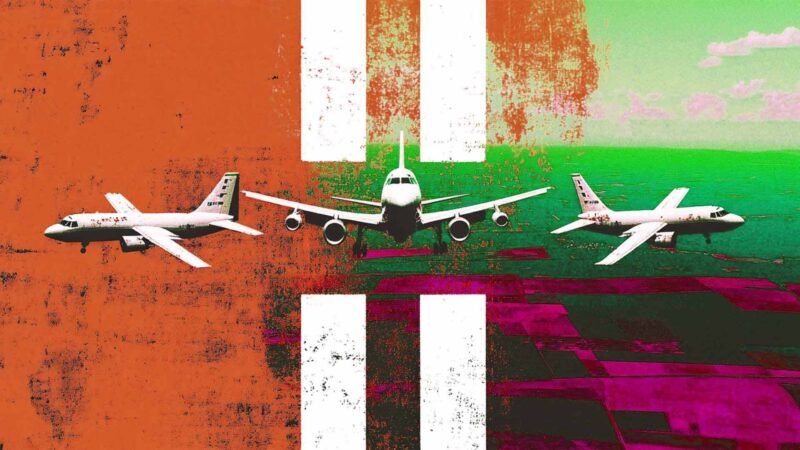The 3 FAA Failures Creating a Dangerous Mess in the Skies
Outages, staffing shortages, and outdated tech are crippling air traffic control and putting the public at risk. It's time to take the job away from the FAA.

Air traffic controllers handling flights for Newark Liberty International Airport experienced another troubling communications outage on Monday. It is the region's fourth reported air traffic control outage in the last few weeks, raising serious safety concerns and contributing to a nightmare of flight delays and cancellations for travelers flying in and out of Newark.
On multiple occasions since April 28, air traffic controllers have temporarily lost radar or communications with planes around Newark Airport—once for up to 90 seconds—spurring Federal Aviation Administration (FAA) investigations, making national news, and prompting a recent Saturday Night Live sketch that illustrated how mainstream concerns about air traffic control safety have suddenly become.
Three problems are occurring simultaneously here, each making the other problems worse. First, one of the airport's three runways is out of service for refurbishment until later this summer. Being down a runway reduces the number of flights that can depart and arrive, and by itself would lead to fewer than normal choices for passengers.
Second is a severe shortage of air traffic controllers in the facilities that manage the airspace for Newark and other New Jersey airports. Across the country, the FAA is woefully short of air traffic controllers, partly because it still has not developed a staffing model that accurately projects both additions and deletions to the controller workforce. The agency touts the number of new hires each year, neglecting both the washout rate from training and the expected number of controller resignations and retirements. Most years don't see a net increase in the number of air traffic controllers.
As detailed in a 2023 Department of Transportation inspector general report, the Philadelphia control tower and Terminal Radar Approach Control (TRACON) facility, which services Newark's airspace, were among the least understaffed of major FAA facilities. But The New York Times recently reported on the critical air traffic control understaffing issues now impacting Newark Airport. The Philadelphia TRACON that is responsible for managing Newark's airspace has "only 22 controllers certified to guide planes in and out of the airport," the Times reports—significantly lower than the FAA's target of 38 controllers. "The overall staffing level of the Philadelphia facility, which is also responsible for several other airports in the region, is about 70 percent."
And even fewer controllers are often available to work. The Times notes that as few as "three air traffic controllers were scheduled during a period on Monday evening at the [Philadelphia] facility that guides planes in and out of Newark—far short of the target of 14 for that shift."
That brings us to the third problem: the air traffic control system's obsolete communications technology. All the flight data from New Jersey airports (Newark, Teterboro, and Morristown) get transmitted to Philadelphia via a 25-year-old telecommunications system and routed to a controller display system called STARS, the Standard Terminal Automation Replacement System. STARS processes radar data for Newark and, according to the FAA, "telecommunications lines feed this data from New York to the Philadelphia TRACON, where controllers handle Newark arrivals and departures."
STARS was designed to read obsolete "time-division multiplexing" data from the transmission system, whose copper wires are wearing out and don't have enough capacity. For years, the vendor working with the FAA to upgrade the system has been patching up that system with "pseudowire" that gets overloaded and loses packets of information, causing blank control screens and no voice communications with aircraft cockpit crews. This was flagged as a serious problem at the Los Angeles TRACON in 2022 and 2023, when there were five incidents of display screens going blank at various air traffic control towers in the region. Investigation of those failures identified "a vulnerability caused by two specific characteristics in the STARS software architecture" that displays flight data to controllers, according to a leaked November 2023 internal FAA report called "STARS Remote Tower Failures Background." To the best of my knowledge, the FAA never disclosed this 2023-identified failure built into STARS to the outside world. But it did hold internal meetings to discuss the problem.
The situation in Newark is far worse, because both the radar data and communications data there have no backup systems. Losing both at Newark is far more serious than the failures at Los Angeles TRACON.
With Newark Airport's outages increasing the scrutiny on the FAA's failed technology and long-delayed modernization efforts, Forbes recently described the agency's latest plan to update its communications infrastructure. It involves "adding three new, high-bandwidth telecommunications connections" between the New York TRACON and the Philadelphia TRACON "to provide more speed, reliability and redundancy," and to establish a STARS hub that doesn't depend on a telecommunications feed from the New York hub. An FAA spokesperson told Forbes that improvements will be implemented "in the coming weeks and others in the coming months, and all by the end of the year."
The problems at Newark are yet another example of our inadequate air traffic control system. The United States needs to separate aviation safety regulation from air traffic control operations. When the FAA both manages and regulates air traffic control, there is an inherent conflict of interest.
Today, more than 80 countries have air traffic control systems that are public utilities funded by user fees, allowing them to generate money quickly, issue revenue bonds, replace aging facilities, update their technology, and hire skilled staff while being directly accountable to customers. The U.S. is one of the few countries that hasn't adopted this approach to air traffic control. The results are understaffing, outdated technology, and a lack of meaningful oversight—all combining to put travelers at risk.
Read full policy study here.


Show Comments (10)